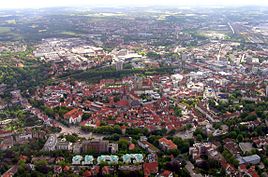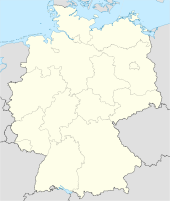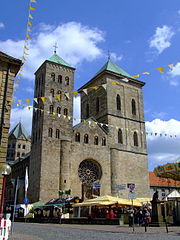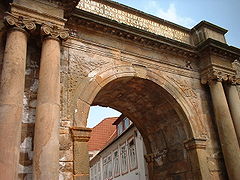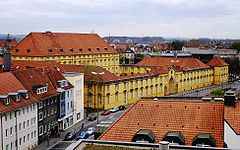- Osnabrück
-
Osnabrück 
Coordinates 52°16′44″N 8°2′35″E / 52.27889°N 8.04306°ECoordinates: 52°16′44″N 8°2′35″E / 52.27889°N 8.04306°E Administration Country Germany State Lower Saxony District Urban district Lord Mayor Boris Pistorius (SPD) Basic statistics Area 119.80 km2 (46.26 sq mi) Elevation 63 m (207 ft) Population 164,119 (31 December 2010)[1] - Density 1,370 /km2 (3,548 /sq mi) - Metro 272,674 Other information Time zone CET/CEST (UTC+1/+2) Licence plate OS Postal codes 49074–49090 Area code 0541 Website www.osnabrueck.de Osnabrück (German pronunciation: [ɔsnaˈbʁʏk]; Low German: Ossenbrügge) is a city in Lower Saxony, Germany, some 80 km NNE of Dortmund, 45 km NE of Münster, and some 100 km due west of Hanover. It lies in a valley penned between the Wiehen Hills and the northern tip of the Teutoburg Forest. As of December 31, 2010, its population was 164,119, making it the third-largest city in Lower Saxony.[2]
Contents
History
Medieval
Osnabrück developed as a marketplace next to the bishop's see founded by Charlemagne, king of the Franks, 780. Some time before 803, the city became seat of the Prince-Bishopric of Osnabrück. Although the precise date is uncertain, Osnabrück is likely the oldest bishopric in Lower Saxony.
In the year 804 Charlemagne was said to have founded the Gymnasium Carolinum in Osnabrück. This date would make it the oldest German Gymnasium but the charter date is disputed by historians, some of whom believe it could be a forgery.
In 889 the town was given merchant, customs, and coinage privileges by King Arnulf of Carinthia. It is first mentioned as a "city" in records in 1147. Shortly after in 1157, Emperor Frederick Barbarossa granted the city fortification privileges (Befestigungsrecht). Part of the medieval fortification, most of the towers are still visible in the city. Osnabrück became a member of the Hanseatic League in the 12th century, as well as a member of the Westphalian Federation of Cities.
Early Modern age
The main period of witch hunting in Osnabrück was between 1561 and 1639, a time of social unrest and tensions because of the Protestant Reformation and the European wars of religion. In the year 1582 during the reign of mayor Hammacher (1565–1588), 163 women were killed as alleged witches, most of them burned. During the tenure of mayor Dr. Pelster between 1636–1639, more than 40 women were killed as witches. In total, 276 women and 2 men were executed after a witch trial for wizardry.
In 1632 a Jesuit university was founded, based on the Gymnasium Carolinum. One year later it was closed under the Swedish reign of the Prince-Bishop. Between 1643-1648 negotiations in Münster and Osnabrück led to the Peace of Westphalia.
In the early 18th century, Osnabrück native Justus Möser wrote an influential social and constitutional history, the Osnabrücker Geschichte, in the town.[3] Following the Seven Years' War, the town's population fell below 6,000, but an economic revival based on the linen and tobacco industries brought growth from the 1780s.[4]
19th century
The French Revolutionary Wars brought Prussian troops into the city in 1795, followed by the French in 1803.[5] The town's population remained below 10,000 in this first decade of the nineteenth century.[5] Control of Osnabrück passed to the Electorate of Hanover in 1803 during the German Mediatisation and then briefly to the Kingdom of Prussia in 1806. It was part of the Kingdom of Westphalia from 1807–10, after which it passed to the First French Empire. After the Napoleonic Wars, it became part of the Kingdom of Hanover in 1815.
The town's first railroad was built in 1855, connecting it with Löhne. Further rail connections were built in the following decades, connecting Osnabrück with Emden in 1856, Cologne in 1871, and Hamburg in 1874.[6] In 1866 Osnabrück was annexed by Prussia after the Austro-Prussian War and administered within the Province of Hanover. Economic and population growth was fueled by the expansions in the engineering and textile industries, with the Hammsersen weaving mill established in 1869 and the Osnabrücker Kupfer- und Drahtwerk metallurgical firm following in 1873.[5] The last half of the century also brought the expansion of schools and the arrival of electrification and modern sanitation systems.[7]
20th century
In 1914 Osnabrück had over 70,000 inhabitants.[5] The outbreak of the First World War brought food rationing; the Allied blockade and a harsh winter in 1917 led to further shortages.[7] Following Germany's defeat in 1918 a council of workers and soldiers appeared during the November Revolution but was replaced by the new Weimar Republic in the following year.[8] As in other parts of Germany, Osnabrück experienced inflation and unemployment in the 1920s, with over 2,000 out of work in 1923 and nearly 14,000 receiving some kind of government assistance in 1928.[9]
Politically, Osnabrück in the 1920s was a bastion of support for the Social Democrats and the Catholic Centre Party. However, in the Reichstag elections of September 1930, the Nazi party received the highest percentage of votes in the city (nearly 28%), exceeding all the other parties. This was a significant increase on their electoral performance of 1928, when only 3.7% of Osnabrückers had supported the party.[10] During the campaigns prior to the two federal elections of 1932, both Adolf Hitler and Joseph Goebbels made speeches before crowds of thousands in the city.[11]
Following the Nazi seizure of power in January 1933, Osnabrück saw the implementation of National Socialist economic, political, and social programs. These resulted in economic growth for ethnic Germans who did not run afoul of the new regime, and the town went from over 10,000 unemployed in early 1933 to an actual labor shortage by 1938.[12] However, dissenters, supporters of left-wing political parties, and Jews did not share in this growth and found themselves discriminated against, imprisoned, or forced to close their businesses and leave town as Nazi pressure increased as the Second World War approached.[13] During the war, both Jews and Romany were deported to concentration camps and extermination camps [14] The city suffered heavy bombing during World War II, but was rebuilt after the war. In January 2009, 15,000 residents were evacuated when German bomb disposal teams had to come in and defuse two 250 kg (551 lb) World War II bombs.
The war ended in Osnabrück on April 4, 1945, when the XVII Corps of Montgomery's Second Army entered the city with little resistance.[15] Leading Nazis fled the city and the British appointed a new mayor, Johannes Petermann. However, power rested chiefly with the occupiers, represented locally by the military governor, Colonel Geoffrey Day.[16] Relations between the occupiers and the people of Osnabrück were generally peaceful, though tensions existed; some small fights broke out between British soldiers and local youths and some Osnabrückers resented the relationships that developed between the occupiers and local women.[17] Additionally, the British took over more than seventy homes for their own use by the middle of 1946.[18] Amidst shortages, the black market thrived and became a main focus of police activity.[19]
After World War II, when West Germany realigned its states, the city became part of the new state of Lower Saxony in 1946.
Main sights
Heger Tor, formerly called Waterloo Tor, a memorial to Elector Georg's 'German' Legion in Osnabrück.
- Town Hall
- St. Peter's Cathedral, founded in the 11th century. It has two façade towers, originally of the same size.
- Gerdrudenberg Monastery
- Marienkirche
- Heger Tor ("Heger Gate"), a monument to the soldiers from Osnabrück who died at the battle of Waterloo (1815).
- Bucksturm, the oldest tower in the city, and once part of the city walls. It was once used as prison for women accused of witchcraft.
- Ruwe Fountain" (1985), created for the city's 1200th birthday.
- Gladiator 2000 (1986), a gigantic painting (45 × 6 meters) by Nicolae Covaci.
- Felix Nussbaum Haus, a Gallery and Museum dedicated to the Jewish artist and painter Felix Nussbaum, who died in the Holocaust. It was designed by the architect Daniel Libeskind.
- Kalkriese Museum, situated on the battlefield of the Teutoburger Wald, in which German tribes under Arminius destroyed three Roman legions. It exhibits artefacts unearthed on the battlefield and tells the story of the battle.
- Osnabrück Castle, nowadays the main building of the University of Osnabrück
- Botanischer Garten der Universität Osnabrück, the university's botanical garden
- Old town with its small streets with buildings from middle-age
- Zoo of Osnabrück
- Vitischanze - old time defence station at the north west point of the old city, has the only undestroyed bridge in Europe with a so called defence walk below the bridge's surface walk, casino is installed within the Vitischanze, nearby a parking house called Vitischanze
- Haseuferweg
- Katharinenkirche (St. Catherine's Church) that dates back to 1248 and is one of the 150 tallest churches in the world and the tallest medieval building in the state of Lower Saxony.[20]
Famous people
Personalities from Osnabrück include the writer Erich Maria Remarque and the painters Friedrich Vordemberge-Gildewart and Felix Nussbaum. For the Jewish painter Nussbaum the city erected a very modern museum designed by Daniel Libeskind that opened in 1998. This looks like a scaled-down version of the same architect's well-known Jewish Museum in Berlin. British King George I was born and raised here, and the poet and scholar Johann Ernst Hanxleden was born in Osnabrück, as was the President of Germany Christian Wulff, and reggae musician Gentleman. Victory Records recording artists Waterdown, known for their catchy post-hardcore sound, are based in Osnabrück. Actress Birgitta Tolksdorf, who made a name for herself in American television in the 1970s, as well as Peter van Pels, love interest of famous diarist Anne Frank, and his parents Auguste van Pels and Hermann van Pels, who would later gain fame from their roles in Anne's diary, all hailed from Osnabrück. The famous German stage and screen actor Mathias Wieman (1958 recipient of the Justus-Möser-Medaille) (see German article Justus-Möser-Medaille) was born and raised in the city. Singer Kwon-Twon of Lincoln NE was born and raised here until the age of 16.
Friedrich Clemens Gerke (* 22 January 1801 Osnabrück was a German writer, journalist, musician and pioneer of telegraphy who revised the Morse code in 1848. It is Gerke's notation which is used today.
Economy
Hellmann Worldwide Logistics has its headquarters in the city.[21]
Education
Two institutes of higher education exist in Osnabrück, the Universität Osnabrück (University of Osnabrück) and the Fachhochschule Osnabrück (University of Applied Science of Osnabrück). There also are all kinds of German grammar schools, including seven Gymnasien. As mentioned above, one of them, The Carolinum, may be the oldest school in Germany, which still exists today.
Transportation
The city of Osnabrück is connected by road to the A1, the A30 and the A33. It shares the Münster Osnabrück International Airport together with the nearby city of Münster.
The "Hauptbahnhof" (Main Station) of Osnabrück is an important railway station. Travellers from the Netherlands heading for either Hamburg and Denmark, or Berlin and Eastern Europe, often have to change here.[citation needed]
An extensive bus service operated by Stadtwerke Osnabrück provides transportation within Osnabrück and the surrounding region.[1] The primary bus center is located at the Neumarkt shopping area, a short distance from the train station.
Boroughs of Osnabrück
The city is divided into 23 boroughs:
- 01 Innenstadt ("Centre")
- 02 Weststadt ("Westerntown")
- 03 Westerberg ("Western-mountain")
- 04 Eversburg
- 05 Hafen ("Harbour")
- 06 Sonnenhügel ("Sunhill")
- 07 Haste
- 08 Dodesheide ("Death's Heath"
- 09 Gartlage
- 10 Schinkel
- 11 Widukindland
- 12 Schinkel-Ost
- 13 Fledder
- 14 Schölerberg
- 15 Kalkhügel ("Limehill")
- 16 Wüste ("Desert")
- 17 Sutthausen ("South village"
- 18 Hellern
- 19 Atter
- 20 Pye
- 21 Darum/Gretesch/Lüstringen
- 22 Voxtrup
- 23 Nahne
Name
The origin of the name Osnabrück is disputed. The suffix -brück suggests a bridge over or to something (from German Brücke = bridge) but the prefix Osna- is explained in at least two different ways: the traditional explanation is that today's name is a corruption of Ochsenbrücke (meaning "ox' bridge") but others say that it is derived from the name of the Hase River which again is argued to be derived from Asen (Æsir), giving Osnabrück the meaning Bridge to the Gods.[22] The pronunciation of the city's name can also serve as a means of telling if one is a native of Osnabrück or a visitor: most people from Osnabrück stress the last syllable while most people from elsewhere stress the first one. The city gave name to the textile fabric of Osnaburg (remember: "-burg" means castle and, in names, town).
Notable residents
- Erich Maria Remarque, famous writer
- Heinrich Abeken, German theologian and Prussian Privy Legation Councillor in the Ministry of Foreign Affairs in Berlin
- Felix Nussbaum, known mostly for his surrealist paintings
- Christian Wulff, President of Germany and former Minister-President of Lower Saxony
- Hans-Gert Pöttering, former President of the European Parliament
- Mathias Wieman, famous actor
- Tillman Otto a.k.a. Gentleman, reggae musician
International relations
Osnabrück is twinned with:
 Haarlem, Netherlands, since 1961
Haarlem, Netherlands, since 1961 Angers, France, since 1964
Angers, France, since 1964 Gmünd, Austria, since 1971 (friendship link)
Gmünd, Austria, since 1971 (friendship link) Derby, United Kingdom, since 1976
Derby, United Kingdom, since 1976 Greifswald, Germany, since 1988
Greifswald, Germany, since 1988 Tver, Russian Federation, since 1991
Tver, Russian Federation, since 1991
 Evansville, United States, since 1991 (friendship link)
Evansville, United States, since 1991 (friendship link) Gwangmyeong, Korea, since 1997 (friendship link)
Gwangmyeong, Korea, since 1997 (friendship link) Çanakkale, Turkey, since 2004
Çanakkale, Turkey, since 2004 Vila Real, Portugal, since 2005
Vila Real, Portugal, since 2005 Hefei, China, since 2006 (friendship link)
Hefei, China, since 2006 (friendship link)
Twinning with Derby
Osnabrück is twinned with Derby in England. The partnership treaty between the two cities was signed on 17 February 1976.
Osnabrück made contact with the British authorities as early as 1948, hoping to find an English twin town and therefore reach an understanding with their former enemies from the Second World War. Unfortunately this attempt was unsuccessful and Osnabrück did not consider an English twin town again until 1972. The twinning agreement with Derby was signed four years later in the historical Hall of Peace in Osnabrück's town hall. Since then the two towns have exchanged envoys. Derby also has a square named after Osnabrück, with an obelisk to commemorate the twinning.
Osnabrück now has eleven twin and friendship cities: Derby (England), Angers (France), Haarlem (Netherlands), Çanakkale (Turkey), Tver (Russia), Greifswald (Germany), Vila Real (Portugal), Hefei (China), Evansville (USA), Gmünd (Austria), Gwangmyeong (Korea) and there are five envoys working at the twinning office in Osnabrück, who represent Derby, Angers, Haarlem, Tver and Çanakkale.
Every year, Derby and Osnabrück each appoint an Envoy who spends twelve months in his or her twin city. The Envoy's role is varied, but encompasses areas such as promoting the exchange of ideas between the two cities, as well as acting as an educational and general information officer to promote awareness of the twinning scheme. They can help in all sorts of ways by: translating, giving talks to local societies and schools, finding pen friends and short term host families during work placements, working in day-to-day contact to assist groups who want to get involved in twinning by identifying and approaching possible counterparts, planning the annual mayweek trip and a lot more.
The exchange of Envoys between two cities is very unusual. The team of Envoys in Osnabrück changes every year and Osnabrück also sends envoys to Derby, Angers and Çanakkale. No other city in Germany participates in this exchange of Envoys, and in Britain, only one other city, Wigan, receives and sends an Envoy.
The twinning gives the inhabitants of both places the opportunity to interact with their international neighbours. Town twinning intends to enhance international understanding and break down social barriers.
References
Bibliography
- Gerd Steinwascher (editor): Geschichte der Stadt Osnabrück Meinders & Elstermann, Belm 2006, ISBN 3-88926-007-1
- Bettina Meckel: Osnabrück und Umfeld. Wenner, Osnabrück, 2010. ISBN 978-3-87898-417-7
Notes
- ^ "Bevölkerungsfortschreibung" (in German). Landesbetrieb für Statistik und Kommunikationstechnologie Niedersachsen. 31 December 2009. http://www1.nls.niedersachsen.de/statistik/html/parametereingabe.asp?DT=K1000014&CM=Bev%F6lkerungsfortschreibung.
- ^ http://www.osnabrück.de/images_design/Grafiken_Inhalt_Rathaus_online/Amtliche_Einwohnerzahlen_der_Stadt_Osnabrueck_und_der_angrenzenden_Gemeinden.pdf
- ^ Panayi, P. Life and Death in a German Town: Osnabrück from the Weimar Republic to World War II and Beyond. New York: Tauris Academic Studies, 2007. p 15-16.
- ^ Panayi 2007, p. 15.
- ^ a b c d Panayi 2007, p. 16.
- ^ Panayi 2007, p. 16-17.
- ^ a b Panayi 2007, p. 17.
- ^ Panayi 2007, p. 17-18.
- ^ Panayi 2007, p. 18.
- ^ Panayi 2007, p. 37.
- ^ Panayi 2007, p. 44.
- ^ Panayi 2007, p. 55.
- ^ Panayi 2007, p. 23-24,81, 186-200.
- ^ Panayi 2007, p. 197-98,211.
- ^ Panayi 2007, p. 137.
- ^ Panayi 2007, p. 135,137.
- ^ Panayi 2007, p. 136-37.
- ^ Panayi 2007, p. 150-51.
- ^ Panayi 2007, p. 153-56.
- ^ "Höchstes mittelalterliches Bauwerk Niedersachsens". Osnabrück civic site. http://www.osnabrueck.de/10341.asp. Retrieved 7 November 2011.
- ^ "Imprint." Hellmann Worldwide Logistics. Retrieved on September 3, 2011. "Hellmann Worldwide Logistics GmbH & Co. KG Elbestrasse 1 D-49090 Osnabrueck"
- ^ Environmental Education at the University of Osnabrück (German)
External links
- Official website (German)
- Horses & Dreams Annual Horse Dressage Show
- Independent Film Festival Osnabrueck official website Unabhaengiges FilmFest Osnabrueck
- The Ostensibles English Theatre in Osnabrueck, official website
Cities in Germany by population 1,000,000+ 500,000+ 200,000+ Aachen · Augsburg · Bielefeld · Bochum · Bonn · Braunschweig · Chemnitz · Duisburg · Erfurt · Freiburg im Breisgau · Gelsenkirchen · Halle an der Saale · Karlsruhe · Kiel · Krefeld · Lübeck · Magdeburg · Mannheim · Münster · Mönchengladbach · Oberhausen · Rostock · Wiesbaden · Wuppertal
100,000+ Bergisch Gladbach · Bottrop · Bremerhaven · Cottbus · Darmstadt · Erlangen · Fürth · Göttingen · Hagen · Hamm · Heidelberg · Heilbronn · Herne · Hildesheim · Ingolstadt · Jena · Kassel · Koblenz · Leverkusen · Ludwigshafen · Mainz · Moers · Mülheim an der Ruhr · Neuss · Offenbach am Main · Oldenburg · Osnabrück · Paderborn · Pforzheim · Potsdam · Recklinghausen · Regensburg · Remscheid · Reutlingen · Saarbrücken · Salzgitter · Siegen · Solingen · Trier · Ulm · Wolfsburg · Würzburg
complete list · municipalities · metropolitan regions · cities with more than 100,000 inhabitants Members of the Hanseatic League by Quarter Chief cities are highlighted; Free Imperial Cities of the Holy Roman Empire are shown in italics. Wendish Quarter Anklam · Demmin · Greifswald · Hamburg · Kolberg (Kołobrzeg) · Lüneburg · Rostock · Rügenwalde (Darłowo) · Stettin (Szczecin) · Stolp (Słupsk) · Stockholm · Stralsund · Visby · Wismar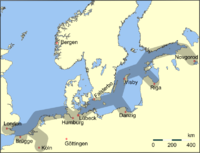
Saxon Quarter Baltic Quarter Westphalian
QuarterPrincipal Kontore Subsidiary Kontore Other cities * Cologne and Dortmund were both capital of the Westphalian Quarter at different times.
† Antwerp gained importance once Bruges became inaccessible due to the silting of the Zwin channel. Urban and rural districts in the state of Lower Saxony in Germany
Urban and rural districts in the state of Lower Saxony in Germany 
Region HanoverUrban districts Rural districts Ammerland · Aurich · Bentheim · Celle · Cloppenburg · Cuxhaven · Diepholz · Emsland · Friesland · Gifhorn · Goslar · Göttingen · Hamelin-Pyrmont · Harburg · Heidekreis · Helmstedt · Hildesheim · Holzminden · Leer · Lüchow-Dannenberg · Lüneburg · Nienburg · Northeim · Oldenburg · Osnabrück · Osterholz · Osterode · Peine · Rotenburg · Schaumburg · Stade · Uelzen · Vechta · Verden · Wesermarsch · Wittmund · WolfenbüttelCategories:- Cities in Lower Saxony
- 780 establishments
- Osnabrück
- Populated places established in the 8th century
Wikimedia Foundation. 2010.

